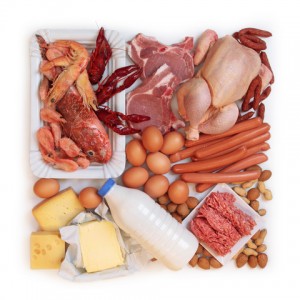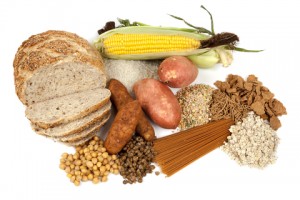Macronutrients are protein, carbohydrates, and fats. These are essential nutrients that should be consumed in large amounts in which the body needs for proper growth and development. Without proper consumption of these nutrients the human body would suffer adverse health effects, two of which include being overweight and overfat. We will discuss the basics of nutrition, giving you insight into the body’s needs and uses of macronutrients and how to use all three in helping to lose body fat, control body weight, and live a healthy lifestyle without giving up the foods that you enjoy.
Protein
 Protein is a nutrient needed in the diet for the growth and maintenance of muscle, skin, hair and nails. It is also an important part of our immune system to help fight against infections. Getting protein into your body immediately after exercise is highly recommended in order to help with repairing and building of muscle fibers.
Protein is a nutrient needed in the diet for the growth and maintenance of muscle, skin, hair and nails. It is also an important part of our immune system to help fight against infections. Getting protein into your body immediately after exercise is highly recommended in order to help with repairing and building of muscle fibers.
Amino acids make up protein. Most foods derived from plants do not have certain amino acids thus making these foods incomplete proteins. Lacking amino acids can cause health problems and will also slow down the potential for growth and development of muscle tissue. Vegetarians must make an extra effort to combine plant foods that will supply the body with all 20 amino acids needed to make a complete protein (i.e. beans and rice make a complete protein).
Foods that provide complete, quality protein include:
- poultry
- fish
- eggs
- cheese
- milk
- meat
- soy products
- tofu
- nuts
Vegetables and fruits are not a good source of complete protein.
The Recommended Dietary Allowance (RDA) for protein is 0.8 grams (g) for each kilogram (2.2 pounds) of body weight. It is recommended that individual’s daily intake of protein to be 10-35% of calories (kcal) consumed/day. Based on a 2,000 kcal/day diet, this would be 50g to 175g of protein consumed/day. This wide range depends on an individual’s physical activity and health condition. Most Americans regularly consume more than the RDA, often in the form of meat, which can be high in saturated fat. Fish and poultry are the best high quality protein foods that have very low amounts of saturated fat.
Carbohydrates
 Carbohydrates are the body’s number one source of energy. Glucose, or blood sugar, from carbohydrates provides direct energy for the brain, central nervous system, and muscle cells.
Carbohydrates are the body’s number one source of energy. Glucose, or blood sugar, from carbohydrates provides direct energy for the brain, central nervous system, and muscle cells.
There are two types of carbohydrates: simple carbohydrates and complex carbohydrates.
Simple carbohydrates consist of sugars. Simple sugars can be found in fruits, baked goods, pastries, and processed foods. Sugars are not a good source of high-energy carbohydrates.
Complex carbohydrates consist of starches and fiber and are best for maintaining high energy levels. These include rice, grains, pasta, breads, and beans. Complex carbohydrates high in fiber are fruits, vegetables, and whole wheat or multi-grain products.
The best complex carbohydrates to consume for high energy include:
- brown rice
- bran
- whole wheat or multi-grain breads
- wheat pasta
- high fiber cereals
- beans
- kasha
- couscous
- polenta
The best complex carbohydrates to consume for fiber include:
- all vegetables
- all fruits
- whole grain products
Foods that are high in simple sugars such as soda pop, cakes, pies, candy, and many processed foods, such as potato chips, pretzels, corn chips, etc., are not recommended sources of quality complex carbohydrates. Diets consisting of high amounts of simple sugars are usually high in saturated fat and will most likely contribute to weight management problems, low energy levels, and inability to lose body weight/fat.
The RDA for carbohydrates is 45-65% of calories consumed/day. Again, this is a wide range based an individual’s daily physical activity and health condition. Based on a 2,000 kcal/day diet, this would be 225g to 325g of carbohydrates per/day.
Fats
 Fats are an important part of one’s dietary intake. Moderate amounts of fat in our diet are essential in maintaining health and life. Fats are used to provide a ready source of energy, supply the fatty acids necessary for many body chemical activities, and carry the four fat-soluble vitamins: A,D,E, and K. Fat also makes eating more pleasurable, giving foods flavor, aroma, and texture and helps to satisfy hunger.
Fats are an important part of one’s dietary intake. Moderate amounts of fat in our diet are essential in maintaining health and life. Fats are used to provide a ready source of energy, supply the fatty acids necessary for many body chemical activities, and carry the four fat-soluble vitamins: A,D,E, and K. Fat also makes eating more pleasurable, giving foods flavor, aroma, and texture and helps to satisfy hunger.
There are three types of fat: saturated, polyunsaturated, and monounsaturated.
Saturated fats are fats that should be very limited in our diet. A diet high in saturated fats can cause increases in cholesterol levels, which can lead to heart disease and other health problems. Saturated fats are found mostly in animal products such as meats and some dairy products. They can be found in some vegetable oils like coconut oil or palm oil, also in hard margarine and cooking fats. Saturated fats are usually hard at room temperature.
Polyunsaturated and monounsaturated fats are recommended to those that want to lower cholesterol levels. Research has shown that both types of fat play important roles in lowering blood cholesterol levels. Unsaturated fats contain key nutrients called essential fatty acids. Two of the most important are linoleic acid and linolenic acid, both found in vegetable oils. These fatty acids are required for normal growth, skin integrity, and healthy blood and nerves.
Sources of polyunsaturated fats include:
- corn oil
- cottonseed oil
- safflower oil
- soybean oil
- sunflower oil
Sources of monounsaturated oils include:
- canola oil
- olive oil
- peanut oil
- sesame seed oil
- margarine
The RDA for daily fat grams depends on an individual’s age, calories consumed/day, daily physical activity, and the type of fat. The USDA recommends that healthy adults consume 20-35% of their daily caloric intake from fat. Based on a 2,000 kcal/day diet, this would be between 44g and 77g of total fat consumed/day.





